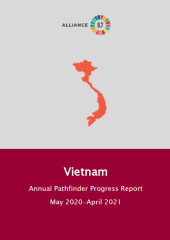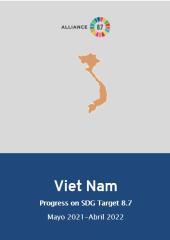Learn more about Vietnam
Priorities
- Establish a National Child Labour and Business Forum that involves SMEs and big brands. A Code of Conduct around child labour, value chains, and sub-contracts should be developed. All actions should comply with international labour standards, especially in the context of Viet Nam’s increased economic integration.
- Provide targeted economic opportunities and social benefits to families of child labourers in need. Minors not in education and already engaged in economic activities should have access to decent and legal work opportunities.
- Implement a social media awareness-raising programme. It should inform the private sector as well as the public about child labour issues.
- Raise awareness about trafficking and improve the means of communications at all levels of government. Communication strategies designed to prevent child labour and trafficking should be created for each target group. Specific activities should be organized for high-risk groups, especially those in remote areas.
- Reduce children’s vulnerability to trafficking. This may be accomplished through employment creation and poverty reduction, as well as theprovision of relevant skills training and income-generating opportunities, particularly in remote regions and within communities of ethnic
minorities.
- Improve the quality of vocational skills training. This may be accomplished through the review and revision of curricula according to market demand.
- Raise awareness among communities, families, and children about the dangers of child labour and inform them about the benefits of education. Develop communication strategies, materials, and activities designed to reduce child labour and child trafficking. Form student clubs and other groups in schools.
- Review the legal framework on child labour and forced labour. A list of hazardous jobs in the agricultural sector should be developed. Laws and decrees on child labour and child protection should impose penalties for deterrence.
- Strengthen poverty reduction and income generating programmes and provide career counselling, vocational skills training, and job placement for older children and youth in rural areas. Formulate pilot models to support families with children. Review support mechanisms and develop preferential mechanisms and policies to encourage private local enterprises to create new job opportunities for local workers.
- Increase awareness-raising and communications around child labour. Communications should focus on the legal framework, the negative effects of child labour on children’s well-being, and poverty reduction. They should target local government institutions, families, parents, and children. Awareness-raising around free trade agreements, as well as the elimination of child labour in agricultural value chains, is also necessary. These communications should target public and private sector enterprises.
Progress
- The MOLISA Inspectorate has issued nationwide guidelines on the process of inspecting and examining the implementation of the law on minor workers in the informal economy for DOLISA inspectors.
- The Department of Children under the Ministry of Labour, Invalids and Social Affairs has issued a process for early detection and intervention support for child labour prevention.
- The indicator on child labour is included in the set of statistical indicators on the situation of children and the situation of child abuse, handling of administrative violations for acts of child abuse.
Child Labour and Business
- Representatives from more than 100 businesses operating in Viet Nam gathered on 27 November in Ho Chi Minh City for a Business Forum co-organized by the VCCI and UNICEF, entitled “Reimagine Responsible Business for a Better World for Children”. The forum served as a platform for business leaders and stakeholders to reimagine child friendly responsible business policies and practices, including issues related to child labour and minor workers.
- Departments of Labour Invalids and Social Affairs (DOLISAs) are continuing to support the implementation of targeted livelihood interventions in selected areas with a goal to eventually scale up and replicate successful models across the country as part of the next phase of the National Action Plan (M) to Prevent and Reduce Child Labour for the Period 2020-2025.
- The World Day Against Child Labour 2020 raised awareness on the heightened risk of child labour resulting from COVID-19. To mark the occasion in Viet Nam, MOLISA collaborated with ILO and UNICEF to host a livestream panel discussion on the topic, with experts from ILO and UNICEF, the Director General of DCA and a parent and teacher affected by the crisis.
- On 27 April 2021, Viet Nam launched its Music Against Child Labour song competition to raise awareness during the International Year for the Elimination of Child Labour, and prepare for upcoming World Day Against Child Labour.
Child trafficking
- In June 2020, within the framework of the Tackling Modern Slavery in Viet Nam project, MOLISA collaborated with World Vision to organize training for operators of the 111 National Child Protection hotline to ensure effective consultation services for trafficking victims.
- During the reporting period, as part of the Tackling Modern Slavery in VN project, the IOM collaborated with Departments of Labour, Invalids and Social Affairs in Ha Tinh and Quang Binh province (both areas that are vulnerable to trafficking) to organize an information fair on employment opportunities for 600 job seekers, community members and students at high schools and vocational schools in the two districts.
- MOLISA has collaborated with World Vision Viet Nam to develop the website and database of the National Child Protection Hotline 111 to increase outreach to trafficking victims and groups being at risk. An application has been developed to synchronise the hotline with Zalo, which is one of the most popular social media applications in Viet Nam, with 50 million users across the country.
Child Labour Prevention and Education
- The Department of Vocational Education and Training (DVET) are implementing capacity building activities to improve vocational education and training in Viet Nam and ensure it meets labour market needs. To this end, DVET has developed Vocational Counselling Guidelines and a Manual on the Development of Training Programmes that meet Labour Market Needs.
- The content for the awareness raising package, Supporting Child’s rights through education, arts and the media (SCREAM) has recently been updated with content from the NCLS 2018 and the Labour Code 2019. Because the approach has proven so successful, MOLISA plans to integrate SCREAM into the awareness raising component of the upcoming NPA/roadmap. Between June and September 2020, 3 trainings on the SCREAM approach were organised.
Child Labour Prevention in Agriculture
- Two significant amendments to the revised Labour Code include a new separate chapter on minor workers, and the expansion of the scope of regulations for workers in both formal and informal settings, where the majority of child labour takes place.
- Hanoi DOLISA and Hanoi Cooperative Alliance (HCA) are providing livelihood support for households with children vulnerable to child labour, based on the results of a rapid needs assessment.
- The Viet Nam Association of Seafood exporters and producers (VASEP) brings together seafood processing and exporting companies in Viet Nam as well as businesses in the service sector related to the fishery industry.
Child labour
- Viet Nam’s second National Child Labour Survey (NCLS) has been completed and the report will be published in August 2020.
- The Labour Code 2019, which comes into effect in 2021, has been revised in alignment with international standards and its scope has been expanded to protect workers in the informal economy, where the majority of child labour takes place. Clearer provisions on minor workers are also provided in the revised
- To guide the implementation of the provisions relating to the minor workers in the revised Labour Code, a circular on regulations and guidelines for implementing legislation on the employment of persons under 15 years of age is currently under development, the MOLISA department for Safe Work is also updating a circular on the list of light jobs permitted for 13 to 15 year olds; a circular on the list of jobs and workplaces prohibited for 15 to 18 year olds, and developing a circular to provide guidance on overtime work and night work undertaken by 15 to 18 year olds.
Human trafficking
- In June 2020, Viet Nam’s National Assembly voted to ratify ILO Convention 105 on forced labour, which will come into force after one year.
- Education, training and livelihood support intervention are being provided to children and families in target provinces
International Instruments
| Area | Ilo Instrument | Status | Ratification date | CEACR comments |
|---|---|---|---|---|
| Child Labour | C138 Ratification of C138 - Minimum Age Convention (1973) |
In Force | 24 Jun 2003 | |
| Child Labour, Forced Labour, Human Trafficking, Modern Slavery | C182 Worst Forms of Child Labour Convention (1999) |
In Force | 19 Dec 2000 | |
| Child Labour, Modern Slavery | C029 Forced Labour Convention (1930) |
In Force | 05 Mar 2007 | |
| Forced Labour, Human Trafficking, Modern Slavery | P029 Protocol of 2014 to the Forced Labour Convention (1930) |
|||
| Forced Labour, Modern Slavery | C105 Abolition of Forced Labour Convention (1957) |
In Force | 14 Jul 2020 | |
| Child Labour, Forced Labour, Human Trafficking, Modern Slavery | C143 Migrant Workers (Supplementary Provisions) Convention (1975) |
|||
| Child Labour, Forced Labour, Human Trafficking, Modern Slavery | C181 Private Employment Agencies Convention (1997) |
|||
| Freedom of Association | C087 Freedom of Association and Protection of the Right to Organise Convention (1948) |
|||
| Freedom of Association | C098 Right to Organise and Collective Bargaining Convention (1949) |
In Force | 05 Jul 2019 | |
| Discrimination | C100 Equal Remuneration Convention (1951) |
In Force | 07 Oct 1997 | |
| Discrimination | C111 Discrimination (Employment and Occupation) Convention (1958) |
In Force | 07 Oct 1997 | |
| Occupational Safety and Health | C155 Occupational Safety and Health Convention (1981) |
In Force | 03 Oct 1994 | |
| Occupational Safety and Health | C187 Promotional Framework for Occupational Safety and Health Convention (2006) |
In Force | 16 May 2014 |
| Area | UN Treaty | Signature date | Ratification date | Status |
|---|---|---|---|---|
| Child Labour | IV-11 Convention on the Rights of the Child (1989) |
26 Jan 1990 | 28 Feb 1990 | |
| Child Labour | IV-11-c Optional Protocol to the Convention on the Rights of the Child on the sale of children, child prostitution and child pornography (2000) |
8 Sep 2000 | 20 Dec 2001 | |
| Forced Labour, Human Trafficking | PALERMO_PROTOCOL Protocol to Prevent, Suppress and Punish Trafficking in Persons, especially Women and Children, supplementing the United Nations Convention against Transnational Organized Crime (2000) |
8 Jun 2012 a | Accession | |
| Human Trafficking, Modern Slavery | XVIII-4 Ratification of the Supplementary Convention on the Abolition and of Slavery, the Slave Trade and Institutions and Practices Similar to Slavery (1956) |
- | - |
Sources: ILO Normlex & UN Treaty Collection

